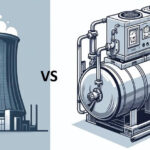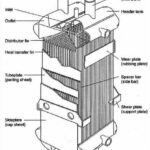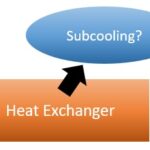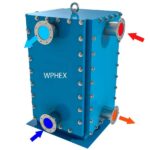What is plate heat exchanger? this article will describe gasketed plate heat exchangers. One of the popular choices for food industry.
What is a Plate Heat Exchanger?
Plate heat exchangers are essentially a number of pressed metal plates, aligned on a frame clamped together with gaskets between the plates. Each pressed plate is corrugated, having a number of alternating ridges and grooves. The pattern and geometry of the corrugations are a function of the design and the desired flow arrangement. The inlet and outlet ports are located in the corners of each plate. Gaskets are installed in grooves on the periphery of each plate. The gaskets contain the fluids and direct the flow distribution. The fluid flows between alternating plates. The flow distribution is controlled by simply removing a portion of the circumferential gasket located on an inlet or outlet port. Intermixing of exchanger fluids is prevented by the circumferential gasket surrounding ports and back-up leakage gaskets that cross the diagonal of the corners near the distribution headers.

Originally applications of plate heat exchangers were tied to industries requiring hygienic conditions such as food, dairy, beer and wine industries. As development occurred applications for plate heat exchangers were discovered in heavy industries such as chemical, petrochemical and other related areas.
Spacing of plates, plays an important part with respect to heat transfer. Plates are spaced with nominal gaps of two (2) to five (5) millimetres (mm). This close spacing provides the same results as using very small diameter tubes which helps to produce high heat transfer coefficients.
Plate heat exchangers require less surface area for heat transfer. The corrugated plates create turbulence, which also promotes high heat transfer rates, by continuously altering the flow direction and velocity of the fluids. Plate heat exchangers are relatively effective with viscous fluids with
viscosities up to about 30 kg/m.sec (300 poise)

Plates: Pressed plates provide corrugations that provide turbulence and surface area for heat transfer.
Ports: Inlet and outlets ports for fluids.
Gaskets: Seals plates and provides back up for leakage protection between fluids.
End Plates: Pressure plates that do not contact fluid which provide pressure to seal gaskets.
Compression Bolts: Bolts used to tighten end plates and provide pressure to seal gaskets.
Carrying Bars: Bars maintain plates in upright position. The upper carrying bar carries the weight of the plates. Plates are installed by sliding them along the carrying bars.
General Guidelines
- Plate thickness is between 0.4 to 0.8 mm
- Channel lengths are normally 2-3 meters
- Plates are available in: Stainless Steel, Titanium, Titanium-Palladium, Nickel
Advantages and Disadvantages
| Advantages | Disadvantages |
|---|---|
| High heat transfer coefficients, reducing the surface area required for a given duty to one third or one half of that required for a tube and shell heat exchanger. | Limited to application by pressure and temperature. Pressure limited to 2.07 Mpa and temperature to 175ºC. Pressure affects plates, frames and gasket sealing. Temperature affects gasket material. |
| Low fouling characteristics due to high turbulence, few stagnant regions and low residence times | Small clearances between plates reduce the size of the largest particle size capable of passing through the PHE. PHE should not be used for fluids with large suspended particles or fibres. |
| Leakage is detected immediately. | Low flow rates creating velocities less than 0.1 m/sec can create flow maldistribution. |
| Floor space required is less as PHE(s) are compact (small liquid hold up, reduced volume and weight). They also require little clearance to dismantle for repair or cleaning. | High pressure drops. Friction factor is high for PHE and PHE have limited entry port diameter. PHE are not suitable for air coolers and gas to gas services. |
| By varying the number of plates the rating of the PHE can be changed easily even after installation. | Not suitable for containing toxic materials or liquids that may form explosive mixtures with air. Leakage is external to the atmosphere and is not contained |
| Better process control is accomplished as the response time is faster and PHE are capable of rapid start-up (related to volume of PHE). | |
| No insulation required (heat loss minimal). | |
| Vibration free. | |
| Capable of withstanding thermal shock. | |
| Close temperature approach is possible thus high efficiencies. | |
| No inter-leakage; can be used for fluids forming an explosive mixture with one another. |
Useful books
1. Hewitt, G.F., Hemisphere handbook of heat exchanger design, Hemisphere Pub. Corp., c1990
2. Kakac, S., Hongtan, L., Heat Exchangers Selection, Rating and Thermal Design, 2nd Edition, CRC Press LLC
Useful Software
Gasketed plate heat exchanger design (PHex) – By Khaled Aljundi – Webbusterz Engineering Software – webbusterz.com










